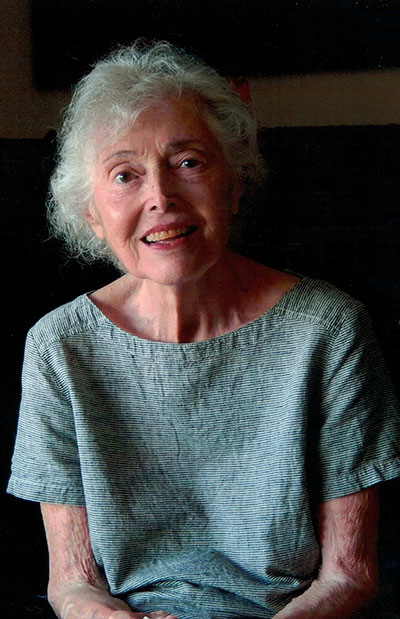In Memoriam: Thelma Jurgrau
 Thelma Jurgrau
Thelma Jurgrau
Lors de la journée d’étude organisée en 2016 à Hofstra University pour fêter les quarante ans de la George Sand Association, j’ai souligné la générosité de Sand, générosité dans le sens matériel, oui, mais, surtout, à l’égard de ses personnages, souvent marginalisés – la courtisane, la fille mère, le champi, la Bohémienne, etc.
Thelma Jurgrau, qui nous a quittés en janvier 2019, possédait, elle aussi, cette qualité. Elle aussi, comme le disait Sand, « aim[ait] à donner et n’aim[ait] pas à compter »[i]. Chaque fois qu’on levait des fonds, Thelma donnait, dans le sens matériel, au prix de la meilleure thèse (que nous avons décerné à Rebecca Sugden lors du banquet du colloque suisse en 2019). Thelma donnait de son temps à l’Association, en écrivant le texte historique pour le site, en préparant la bibliographie des traductions anglaises des œuvres sandiennes, également pour le site, en évaluant des articles proposés à George Sand Studies, en aidant différents membres en difficulté.
Elle a terminé sa thèse, « ‘Pastoral’ and ‘Rustic’ in the Country Novels of George Sand and George Eliot », en 1976, année faste qui a marqué le centenaire du décès de Sand, et la fondation de notre association, car Thelma y était engagée dès le début. Je l’ai rencontrée l’année suivante quand j’ai fait une communication dans une session spéciale Sand du congrès de la Modern Language Association, session que Thelma avait organisée avec Paul Blount. Thelma est surtout connue pour le projet de traduction intégrale en anglais d’Histoire de ma vie par une équipe de soixante-cinq personnes – imaginez un peu la gestion d’une équipe de soixante-cinq personnes avant l’époque des courriels — traduction parue en 1991 aux Presses de SUNY (la State University of New York). Elle a su remanier ces différentes traductions pour en faire un ensemble harmonieux et a également rédigé une longue préface importante. Elle a terminé aussi, ces dernières années, une traduction de Jacques. Mais, pour moi, son travail le plus original se trouvait dans plusieurs articles qu’elle avait publiés sur les personnages juifs dans l’œuvre de Sand[ii]. Sa disparition laisse un grand vide dans nos rangs.
Annabelle M. Rea
——————————————————————
[i] Lettre à Jules Boucoiran, 1831 (Corr. I, p. 801).
[ii] “Antisemitism Revealed in George Sand’s Letters”, Le Siècle de George Sand, Rodopi, 1998, p. 349-56.
“The Changing Image of the Jew and Sand’s Rejection of the Romantic Subject in Valvèdre” George Sand Studies, vol. 21 (2002), p. 102-18.
“George Sand’s Use of Christian Imagery in Four Works Depicting Jewish Characters”, George Sand Studies, vol. 24 (2005), p. 3-23.
Thelma Jurgrau
When I spoke at the 2016 seminar marking the 40th anniversary of the George Sand Association, held at Hofstra University, I underscored Sand’s generosity—generosity in the personal sense, in part, but, especially, generosity in the creation of her often marginalized fictional characters—the courtesan, the unwed mother, the foundling, the “Gypsy,” and so forth.
Thelma Jurgrau, who left us in January 2019, possessed that same quality. She too, as Sand put it in describing herself, “loved to give and didn’t like to count.”i Every time appeals were made for donations, Thelma gave, in the material sense, to the prize for the outstanding dissertation on Sand, for example. She gave her time to the George Sand Association, writing its history for the website, or preparing the bibliography of Sand’s works in English translation, also for the site. She evaluated articles submitted to George Sand Studies, as a member of the Editorial Board, and quietly helped fellow members in difficulty.
She completed her dissertation, “’Pastoral’ and ‘Rustic’ in the Country Novels of George Sand and George Eliot in 1976, that auspicious year marking the centennial of Sand’s death and the creation of the GSA. Thelma was there from the outset. I met her the following year when I gave a paper in a special session of the MLA organized by Thelma, with Paul Blount. Thelma is best known for her project of translating the complete text of Histoire de ma vie with a team of 65 others—just imagine managing 65 people before the days of email!—a translation published as Story of My Life, by SUNY Press in 1991. She managed to harmonize the different submissions into a coherent whole, as well as writing an important preface to the work. In her last years, Thelma also completed a translation of Jacques. For me, however, her most original contribution to Sand studies lies in the articles she wrote on Jewish characters in Sand’s works.ii Her disappearance leaves a great void in our ranks.
Annabelle M. Rea
——————————————————————
